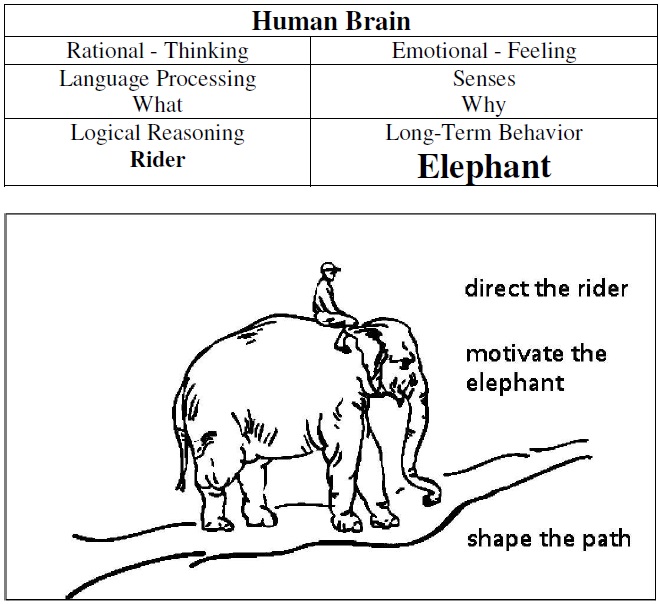
| Volume 31 #6 | May/June 2015 | |
We Scottish dancers like to talk with friends about coming to the classes to try SCD, and we are puzzled why so few people are curious enough to try SCD one time? I visited a website that introduces books by the Heath Brothers http://heathbrothers.com/ and gives insight about two psychological blocks: "Curse of Knowledge" and "Speaking to the Rider instead of the Elephant". The book titled Made to Stick lists six principles that help us overcome the Curse of Knowledge, about how we can deliver ideas that are understood and remembered, and have a lasting impact.
The Tappers and Listeners experiment demonstrates the Curse of Knowledge. Once we know something, we find it hard to imagine what it was like not to know it. Our knowledge has "cursed" us. It becomes difficult for us to share our knowledge with others, because we cannot readily re-create our listenerís state of mind. In the experiment, each tapper was asked to pick a song and tap out the rhythm to a listener, by knocking on a table. The listener's challenging job was to guess the song, based on the rhythm being tapped. Over the course of the experiment, 120 songs were tapped out. Listeners guessed only 2.5 percent of the songs: 3 out of 120. Before the listeners guessed the name of the song, tappers were asked to predict the odds that the listeners would guess correctly. They predicted that the odds were 50 percent. The tappers got their message across 1 time in 40, but they thought they were getting their message across 1 time in 2.
How does the Curse of Knowledge relate to recruiting new Scottish dancers? One example is the use of still photos for publicity, compared with a video. When we experienced dancers view a photo of a dancing set, we can imagine the movement and the beautiful music, while an inexperienced person can see the happy faces and the dancer clothing but totally miss the feeling of dancing.
This leads us to the second psychological block: Speaking to the Rider instead of the Elephant. According to another Heath Brothers book titled Switch - How to Change Things When Change is Hard, the human brain has a rational part (Rider) that can process language and analyze options and determine methods to accomplish goals, and an emotional part (Elephant) that communicates with feelings and significantly governs behavior.

Scottish dance leaders tend to be analytical and communicate in words, like engineers and librarians, while everyone relates to feelings. Messages to recruit new dancers focus on words that are received by the Rider. We need to design feeling messages that speak to the Elephant, since the elephant significantly controls behavior to try dancing. The rider becomes exhausted after trying to influence the elephant. The elephant is unable to relate to words. Better are messages that appeal to the senses. For example, a video that engages the viewer with dancers having fun moving to music is superior to still photos that show neither movement nor music. This relates to the Made to Stick principle of injecting emotions into a message in order to make the audience feel something.
I individually came up with a list of beneficial feelings that unifies the methods I have read or imagined to attract new dancers. I organized the feelings according to the familiar friendship, fun, and fitness categories, and assigned a Strength or priority/importance to the categories. I then wrote a document that describes my favorite tactics in some detail for increasing Scottish country dancers. http://www.rscds-swws.org/news/stories/ReportRscdsTactics.pdf SCD Leaders could similarly build their own list of feelings, and imagine methods to attract new dancers to the beneficial feelings of Scottish Country Dance.
